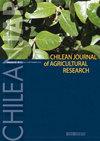Evaluation of volatile compounds in coffee (Coffea arabica L.) beans in response to biochar applications using an electronic nose
IF 1.7
4区 农林科学
Q2 Agricultural and Biological Sciences
引用次数: 0
Abstract
The use of biochar (BC) seems to be a promising alternative for efficient and environmentally friendly waste management that could help to promote cleaner agricultural production. The objective of this research was to evaluate the aromatic profile of coffee ( Coffea arabica L.) beans and cup quality parameters in response to the application of four different doses of biochar (0, 4, 8, and 16 t ha -1 ) obtained from coffee pulp, and four levels of chemical fertilization (CF) (0%, 33%, 66% and 100% of nutritional requirements). An electronic nose was used to analyze volatile compounds and their relationship with coffee quality parameters: Soluble solids (TSS), pH, titratable acidity. Applications of 8 and 16 t ha -1 BC and 66% and 100% CF registered greater sensitivity to the aromatic compounds of roasted coffee beans in sensors W1C, W3C, and W5C. The BC amendments between 8 and 16 t ha -1 and CF 66% and 100% increased the TSS content (CF 66%: 1.32 °Brix and CF 100%: 1.38 °Brix), reduced the pH (CF 66%: 4.95 and CF 100%: 4.88) and increased titratable acidity (CF 66%: 697.88 mg CaCO 3 L -1 and CF 100%: 662.56 mg CaCO 3 L -1 ) in beverages of ‘Castillo El Tambo’ coffee bean in the year 2020. Finally, the co-application of BC as a complement to CF showed a positive effect on the aromatic profile. This methodology could be an original approach to characterize beans according to the coffee crop’s nutritional status, helping in factors focused on quality and traceability.利用电子鼻评价生物炭应用对咖啡(Coffea arabica L.)咖啡豆挥发性化合物的影响
生物炭(BC)的使用似乎是有效和环境友好型废物管理的一种有前途的替代方法,可以帮助促进更清洁的农业生产。本研究的目的是评价4种不同剂量的生物炭(0、4、8和16 t / ha -1)和4种不同水平的化肥(CF)(0%、33%、66%和100%营养需要量)对阿拉比卡咖啡(Coffea arabica L.)咖啡豆芳香特征和杯形品质参数的影响。利用电子鼻分析了咖啡挥发性成分及其与咖啡品质参数:可溶性固形物(TSS)、pH、可滴定酸度的关系。在传感器W1C、W3C和W5C中,应用8和16吨-1 BC和66%和100% CF对烘焙咖啡豆的芳香化合物更敏感。BC在8 ~ 16 t ha -1和CF 66%和100%之间的添加增加了2020年“Castillo El Tambo”咖啡豆饮料中的TSS含量(CF 66%: 1.32°Brix和CF 100%: 1.38°Brix),降低了pH (CF 66%: 4.95和CF 100%: 4.88),增加了可滴定酸度(CF 66%: 697.88 mg CaCO 3 L -1和CF 100%: 662.56 mg CaCO 3 L -1)。最后,BC作为CF的补体共施对其芳香谱有积极的影响。这种方法可能是一种根据咖啡作物的营养状况来描述咖啡豆的原始方法,有助于关注质量和可追溯性的因素。
本文章由计算机程序翻译,如有差异,请以英文原文为准。
求助全文
约1分钟内获得全文
求助全文
来源期刊
CiteScore
3.00
自引率
11.80%
发文量
60
审稿时长
6 months
期刊介绍:
ChileanJAR publishes original Research Articles, Scientific Notes and Reviews of agriculture, multidisciplinary and agronomy: plant production, plant protection, genetic resources and biotechnology, water management, soil sciences, environment, agricultural economics, and animal production (focused in ruminant feeding). The editorial process is a double-blind peer reviewing, Editorial Office checks format, composition, and completeness, which is a requirement to continue the editorial process. Editorial Committee and Reviewers evaluate relevance and scientific merit of manuscript.

 求助内容:
求助内容: 应助结果提醒方式:
应助结果提醒方式:


